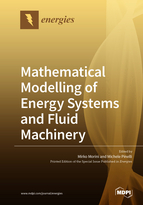Mathematical Modelling of Energy Systems and Fluid Machinery
A special issue of Energies (ISSN 1996-1073). This special issue belongs to the section "J: Thermal Management".
Deadline for manuscript submissions: closed (31 October 2020) | Viewed by 41091
Special Issue Editors
Interests: modelling; district heating networks; electrofuels
Special Issues, Collections and Topics in MDPI journals
Interests: turbomachinery; energy systems
Special Issues, Collections and Topics in MDPI journals
Special Issue Information
Dear Colleagues,
The ongoing digitalization of the energy sector, which will make a large amount of data available, should not be viewed as a passive ICT application for energy technology or a threat to thermodynamics and fluid dynamics, in the light of the competition triggered by data mining and machine learning techniques.
Digitalization creates opportunities, for example, for more sustainable energy systems through the smart management of renewable energy technologies, and for more reliable fluid machines through predictive maintenance.
Nevertheless, this can only be achieved if these new ICT technologies are posed on solid bases for the representation of energy systems and fluid machinery. Therefore, mathematical modelling is still relevant and its importance cannot be underestimated.
This Special Issue is intended for a collection of contributions about mathematical modelling of energy systems and fluid machinery in order to build and consolidate the base of this knowledge.
Authors are invited to submit papers dealing with all aspects of modelling techniques, from the basics of model development (e.g., problem simplification and translation, model implementation, parameter identification, and model validation) to their applications, for all the purposes of interest in energy conversion (e.g., linear models for optimization, 3D CFD for component design, dynamic modelling for system control development, CAE models for production and digital twins for diagnostics and maintenance). Besides original research papers, historical review papers are particularly welcome since they can contribute to the discussion on consolidated assumptions and methodological approaches in the light of the new capabilities provided by modern ICT.
Prof. Dr. Mirko Morini
Prof. Dr. Michele Pinelli
Guest Editors
Manuscript Submission Information
Manuscripts should be submitted online at www.mdpi.com by registering and logging in to this website. Once you are registered, click here to go to the submission form. Manuscripts can be submitted until the deadline. All submissions that pass pre-check are peer-reviewed. Accepted papers will be published continuously in the journal (as soon as accepted) and will be listed together on the special issue website. Research articles, review articles as well as short communications are invited. For planned papers, a title and short abstract (about 100 words) can be sent to the Editorial Office for announcement on this website.
Submitted manuscripts should not have been published previously, nor be under consideration for publication elsewhere (except conference proceedings papers). All manuscripts are thoroughly refereed through a single-blind peer-review process. A guide for authors and other relevant information for submission of manuscripts is available on the Instructions for Authors page. Energies is an international peer-reviewed open access semimonthly journal published by MDPI.
Please visit the Instructions for Authors page before submitting a manuscript. The Article Processing Charge (APC) for publication in this open access journal is 2600 CHF (Swiss Francs). Submitted papers should be well formatted and use good English. Authors may use MDPI's English editing service prior to publication or during author revisions.
Keywords
- Mathematical modelling
- Energy systems
- Fluid machinery
- Modelling techniques
- Computational fluid dynamics
- Dynamic modelling







